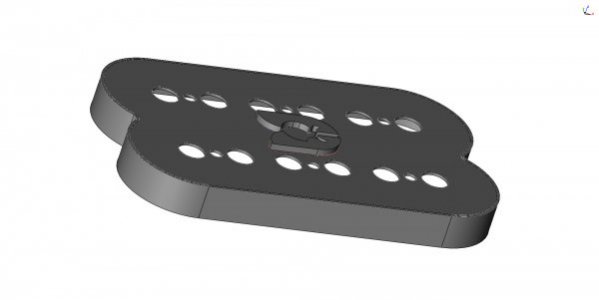-
Welcome back Guest! Did you know you can mentor other members here at H-M? If not, please check out our Relaunch of Hobby Machinist Mentoring Program!
You are using an out of date browser. It may not display this or other websites correctly.
You should upgrade or use an alternative browser.
You should upgrade or use an alternative browser.
Manually milling non-circular curves
- Thread starter Maplehead
- Start date
- Joined
- Feb 14, 2016
- Messages
- 623
All I see there are radii . Maybe I'm missing something because you are showing the part at 45* .
- Joined
- May 9, 2014
- Messages
- 415
All I see there are radii . Maybe I'm missing something because you are showing the part at 45* .
They are covers for a humbucking guitar pickup. Their shape would be properly described as "obround." Think of a rectangle with semi-circle ate each end.
- Joined
- Feb 14, 2016
- Messages
- 623
"Obround" ? I have never heard that before . Teach a old dog a new trick , I don't understand .
https://en.wiktionary.org/wiki/obround
https://en.wiktionary.org/wiki/obround
- Joined
- Feb 9, 2017
- Messages
- 5,537
Those would be hard to press form. Where the 2 radii meet would tear out.
Yup, that's why most of the humbucker pickups covers I saw when I was playing electric were square. I don't think they needed to form fit so tight. And because they damped the output a lotta folks tossed them.
- Joined
- May 9, 2014
- Messages
- 415
You've got it right there from Wikipedia- a rectangle with a semicircle tangent at each end."Obround" ? I have never heard that before . Teach a old dog a new trick , I don't understand .
https://en.wiktionary.org/wiki/obround
Or, the shape of a milled slot, if you prefer.
At one point, the term was pretty foreign to me. When I started with precision sheet metal fabrication back in 1980, it referred to punched slots. I was calling them ovals, but one of my colleagues corrected me. Obrounds have flat sides, ovals are more like ellipses....anyway, it still sounds strange.
Last edited:
- Joined
- Oct 11, 2016
- Messages
- 4,008
The way I was taught to do this was...
Plunge milling, yes I said it! I know I'm beginning to sound like a fanatic, but hear me out:
If you have a DRO, you advance the cutter to each of the pre calculated points. when you are SURE (by checking your layout or cemented template, then you just plunge down. this is very accurate and doesn't involve any risky moves. Also, you get to lock the X and Y travel to make sure your cut is right.
just sayin'
P.S. I have done lots of non-eccentric cam plates like this from paper templates and a loupe. it works very well!
Plunge milling, yes I said it! I know I'm beginning to sound like a fanatic, but hear me out:
If you have a DRO, you advance the cutter to each of the pre calculated points. when you are SURE (by checking your layout or cemented template, then you just plunge down. this is very accurate and doesn't involve any risky moves. Also, you get to lock the X and Y travel to make sure your cut is right.
just sayin'
P.S. I have done lots of non-eccentric cam plates like this from paper templates and a loupe. it works very well!

